Present Continuous TenseIn English, we frequently utilize the Present Continuous tense, and it differs greatly from the Present Simple tense in both structure and usage. The present continuous, also known as the present progressive or the present imperfect, is a modern English verb type that unites the present tense with the continuous aspects. It is appropriate for both the indicative and subjunctive moods. The present continuous version is used by about 5% of phrases in spoken English. The present continuous verb tense suggests that an action or circumstance is occurring now, on a regular basis, and may continue for the foreseeable future. 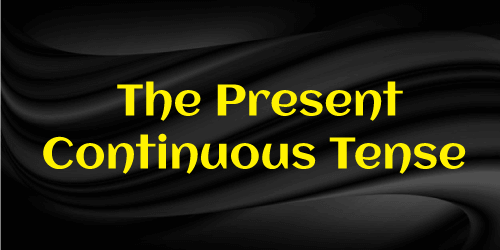
The Present Continuous Formula is as follows: to be [am, is, or are] + verb [present participle] Aunty Claudia is warming up the car while Scott searches for his new long coat. Today, they're dining at Clegg's Cheesecake Dinner, Scott's favorite eatery. The present continuous (present progressive) tense expresses an event or state that is occurring right now, regularly, and maybe continuing. It gives writing more energy and activity, and its influence helps readers realize when the event is taking place. Assume Aunty Michelle has planned to take her cousin Scott out to his favorite restaurant, Sutton's Pancake Kitchen, for his anniversary. I'd use the past tense if I wanted to convey the narrative after it happened: They sat at a red light, and Scott was concerned that they might be late for their appointment. (In the past tense) However, what we need to express is how the incident proceeded, displaying the action as it is occurring: They are residing at Steve's favorite table, the one with the gleaming red wooden benches. (How long will this event last? We're not sure, but we really do know they're sitting there right currently.) The waiter is currently standing behind the station, holding a paper and a pencil behind his ears. (Will he ever come over to the booth?) Possibly, but not just now.) Grandma Caroline is taking a sip of her cold coffee, and while doing this action, she asked, "Are you waiting to receive your gifts after you finish your pies?" (The present continuous is utilized in question form above.) The event is instantaneous and constant from this narrative point of view. There is forward motion, and this tense is often used in fiction to convey suspense or humor. Andrew and his Grandma will order the kind of waffles they want. The tension is destroying me! The Present Continuous Formula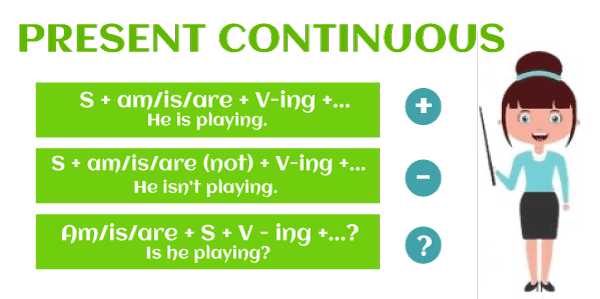
For the proper structuring and formulation of the present continuous tense sentence/ phrase the present continuous, make sure to apply this formula: To Be [Am, Is, Are] + Verb [Present Participle] How can we create a Present Continuous tense?The Present Continuous tense has the following format: In the Present Simple, the auxiliary verb (be) is expressed as follows: am, are, is. The primary verb is always in the present participle form: -ing. We put not between the auxiliary verb and the main verb in negative sentences. We swap the subject and auxiliary verb in questioning phrases. subject + auxiliary be + Primary verb combined in Present Simple am, are, is a present participle (-ing) 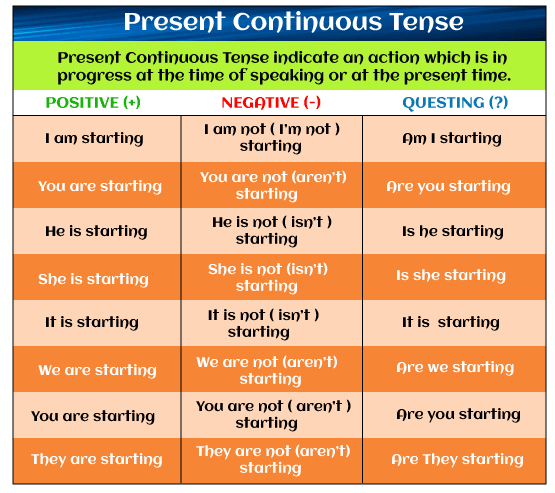
How should the Present Continuous tense be used?We utilize the Present Continuous to discuss:
Present Continuous for the activity taking place right now
For Action Taking Place Around Now The action may not be taking place right now, but it is taking place shortly before and just after currently, and it is not persistent or regular.
When Should You Use the Present Continuous Tense?Always make sure to utilize the present continuous tense with a "to be" verb and a dynamic verb. A dynamic verb depicts an activity and/or a procedure. As an example,
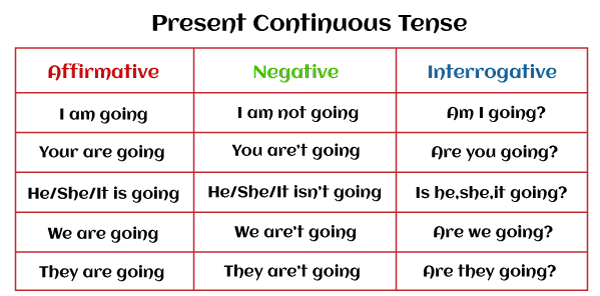
Present Continuous- Negative SentencesTo produce negative phrases in the present continuous, just replace the positive auxiliary verb 'to be' negatively. Subject + am/is/are not + verb +ing Examples:
Continuous Questions in the PresentIn order to ask inquiries in the present continuous, invert the subject and the auxiliary verb 'to be.' So the structure is as follows: Subject + verb +ing + am/is/are Examples:
When using stative verbs, do not utilize the present continuous tense. Stative verbs represent a mode of being which does not change. These verbs can remain in the simple present tense. As an instance, Incorrect Usage: Grandma Mary is preferring the cinnamon walnut waffles to Kyle's apple peanut butter muffins. Correct Usage: Grandma Catherine prefers the cinnamon walnut waffles to Kyle's apple peanut butter muffins. The stative verb "to prefer" expresses opinions in this context and should not be transformed into the present continuous. Emotion (to love), possession (to belong), and thinking (to recognize) are examples of stative verb divisions; therefore, none of these should be used. Now let us see an exception to the rule of Present Continuous Tense Certain verbs can be dynamic as well as stative! Consider the verbs to be and to think. The verb to be can express activity in its dynamic form: Rima, Raju's younger daughter, takes a risk by ordering the red pepper fritters. However, if conjugated in the present continuous, the verb to be in its stative form is problematic. Incorrect Usage: Mary is being a tall adolescent who enjoys spicy food and risky activities. Correct Usage: Jessica is a tall adolescent who enjoys spicy food and risky activities. Here are some further examples: The servant thinks Subhash should save space for desserts. (Stative and in the simple present) The waiter is considering changing jobs to one that involves less social interaction, such as a veterinarian. (Dynamic and continuous in the present) Usageor Applications of Present Continuous TenseThe present continuous can be used in the following contexts: A. To explain an occurence that is happening at the very time of speaking: The youngster is grinning. B. To express an event that is currently taking place but not at the precise moment of speaking: Guys are working in Kuwait. C. To depict the future occurrences (in conjunction with a time indication for the future): I'm re-taking my Hindi exam on Wednesday. D. With always but meaning frequently (used to emphasize the regularity of activity in a comedic or hyperbolic manner): My folks are constantly pressuring me to attend the function! He is always tinkering with that toy! She is always delighting in candy. E. To indicate an activity that is currently under place but is subject to obstruction: Seema cannot answer calls since she is resting. 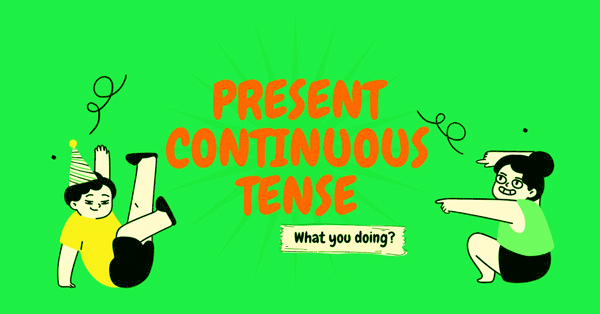
Present Continuous For The FutureIf we add a future term, we may also utilize the Present Continuous tense to communicate about tomorrow. A future phrase must be added (or understood from the situation). Tomorrow, next year, in June, at New Year, and so on are examples of "future words." Once can utilise the Present Continuous tense to express about the future if we have anything prepared before we communicate. Before we spoke, we had already made a choice and a program. My exam is coming up next month. Consider the following examples: We are going to Sam's Cafe for dinner tonight, and we've already reserved a place. He can join you for the meeting on Monday. They aren't functioning. When are you starting your new business? In these situations, there is a definite plan or program in place. Before speaking, a choice and a program were formed. It's worth noting that continuous tenses are also known as progressive tenses. As a result, the Present Continuous tense can sometimes be known as the Present Progressive tense.Importance Of Present Continuous Tense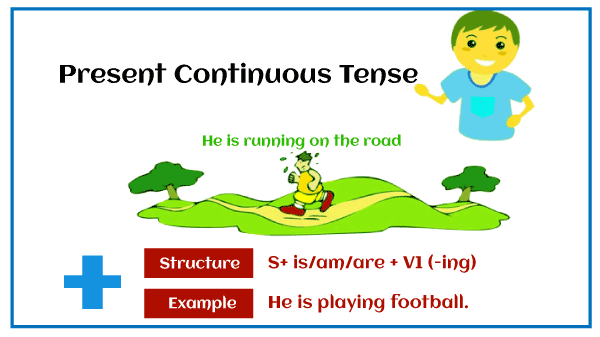
As you can see, in Grammatical rules, the present continuous tense is most commonly employed to indicate a continuous event, something that is incomplete. This tense is especially significant since it is a basic sentence structure that can show actions or events that are taking place currently, in the near future, and even in the past. Styles and Idiomatic ExpressionsEnglish can be perplexing; what is grammatically proper isn't usually what you hear in music, ads, or casual interactions. The present continuous is frequently misused. Consider the famous McDonald's tagline: "I'm Lovin' It." Because love is a stative verb, why would McDonald's utilize it in their ads? This distinguishes between grammar and style. By using present continuous to emphasize is a style tendency, so it would not be unexpected to hear the following conversation: "I'm lovin' me most of these white chocolate fruit waffles!" Smith grins to his grandmother, with his mustache coated in caramel. "I know what you're saying!" replied his Grandma, adding icing sugar on top of the layers on her dish. Smith and his Grandma express their joy humorously, highlighting their emotions. A natural speaker, on the other hand, would never say the following sentences: Incorrect: Smith is loving his Grandma, a conscience pancake expert. (People might just remark, "Smith adores his Grandma ..." Incorrect: Sarah is listening to music from their kitchen counter and suppresses the impulse to perform on it. (Sarah hears music... ) This concludes the Present Continuous Tense.
Next TopicPresent Indefinite Tense
|
 For Videos Join Our Youtube Channel: Join Now
For Videos Join Our Youtube Channel: Join Now
Feedback
- Send your Feedback to [email protected]
Help Others, Please Share









